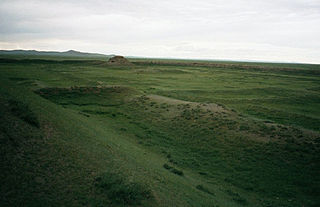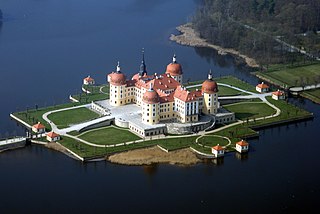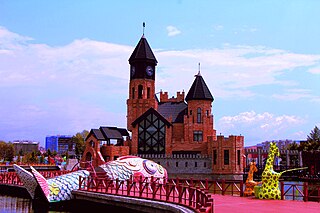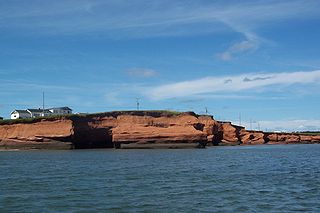Bad Tölz-Wolfratshausen is a Landkreis (district) in Bavaria, Germany. It is bounded by Austria and the districts of Garmisch-Partenkirchen, Weilheim-Schongau, Starnberg, Munich and Miesbach.

Ordu-Baliq, also known as Mubalik and Karabalghasun, was the capital of the first Uyghur Khaganate. It was built on the site of the former Göktürk imperial capital, 27 km north-to-northwest of the later Mongol capital, Karakorum. Its ruins are known as Kharbalgas in Mongolian, which means "black ruins". They form part of the Orkhon Valley Cultural Landscape World Heritage Site.

National Sports Stadium is a multi-purpose stadium in Ulaanbaatar, Mongolia. It is used mostly for football matches and has a capacity 12,500. The Naadam festival, which celebrates Mongolian independence, is held there every July. The land owned by the stadium company is about 27 hectares, of which the stadium takes about 8 hectares of land. The National Sport Stadium in Mongolia hosted the 2016 World University Archery Championship.

Bollschweil Priory was a Cluniac monastery of nuns at Bollschweil in the district of Breisgau-Hochschwarzwald, Baden-Württemberg, Germany.
Bayanzürkh is one of nine Düüregs (districts) of the Mongolian capital of Ulaanbaatar. It is subdivided into 20 Khoroos (subdistricts).

The Khalkh River is a river in eastern Mongolia and northern China's Inner Mongolia region. The river is also referred to with the Mongolian genitive suffix -iin as the Khalkhin Gol, or River of Khalkh.
Chingeltei is one of nine Düüregs (districts) of the Mongolian capital Ulaanbaatar. It is subdivided into 18 Khoroos (subdistricts).
Khan Uul is one of nine Düüregs (districts) of the Mongolian capital of Ulaanbaatar. It is subdivided into 14 Khoroos (subdistricts).

Moritzburg Castle or Moritzburg Palace is a Baroque palace in Moritzburg, in the German state of Saxony, about 13 kilometres (8.1 mi) northwest of the Saxon capital, Dresden. The castle has four round towers and lies on a symmetrical artificial island. It is named after Duke Moritz of Saxony, who had a hunting lodge built there between 1542 and 1546. The surrounding woodlands and lakes were a favourite hunting area of the electors and kings of Saxony.

Altanbulag is a sum of Töv Province in Mongolia.

The architecture of Mongolia is largely based on traditional dwellings, such as the yurt and the tent. During the 16th and 17th centuries, lamaseries were built throughout the country as temples which were later enlarged to accommodate a growing number of worshipers. Mongolian architects designed their temples with six and twelve angles and pyramidal roofs approximating the yurt's round shape. Further expansion led to a quadratic shape in the design of the temples, with roofs in the shape of pole marquees. Trellis walls, roof poles and layers of felt were eventually replaced by stone, brick beams and planks.

Khar-Us Lake is a lake in western Mongolia in the Great Lakes Depression. It is the upper one in a system of the interconnected lakes: Khar-Us, Khar, Dörgön, Airag and Khyargas. The lake is located in Har Us Nuur National Park.

Burg Krems is a castle in Styria, Austria. Burg Krems is 330 metres (1,080 ft) above sea level.

The Château du Hugstein is a ruined castle on the borders of the communes of Buhl and Guebwiller in the Haut-Rhin département of France.

Zuunmod is the administrative seat of Mongolia's Töv Province. It has a population of 16,953 (2017) inhabitants and an area of 19.18 square kilometres. Zuunmod is located on the south side of Bogd Khan Mountain, 43 kilometres (27 mi) south of the capital city of Ulaanbaatar. Zuunmod was established as the administrative center of Töv Province in 1942. Until that time, the administration of the aimag had been located in Ulaanbaatar.
Division No. 1, Subdivision U is an unorganized subdivision on the Avalon Peninsula in Newfoundland and Labrador, Canada, in Division 1. It contains the unincorporated communities of Admiral's Cove, Bauline East, Bauline South, Burnt Cove, Devils Kitchen, Flat Rock, St. Michaels and Seal Cove.
Three Locks is an unincorporated community in Ross County, in the U.S. state of Ohio.

The National Amusement Park is an amusement park in Ulaanbaatar, Mongolia.
This page is based on this
Wikipedia article Text is available under the
CC BY-SA 4.0 license; additional terms may apply.
Images, videos and audio are available under their respective licenses.














